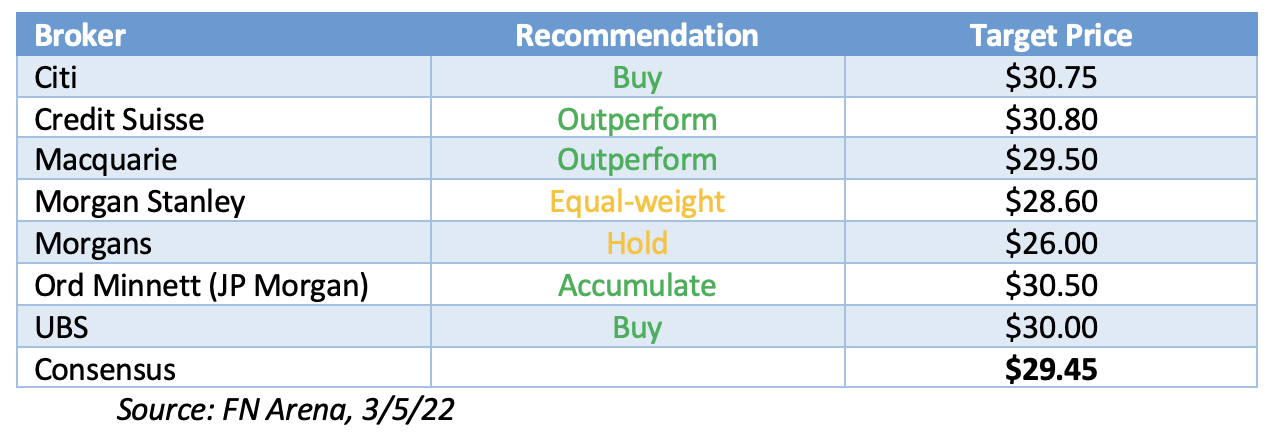When the highlight of your profit result is that ‘our processing times are comparable to our major peers’, it is easy to understand why ANZ (along with Westpac) is the laggard of Australia’s major banks. It is like that after almost 100 years of being in business, ANZ has just discovered what a home loan is!
And they were also celebrating that they managed to grow their home loan book from $278bn to $278.4bn – yes, net growth of $400 million over the six months!
Yesterday, ANZ delivered an underwhelming first-half cash profit of $3.11bn. On paper, it was marginally in front of analysts’ forecasts, but that was because it included net writebacks of credit impairment expenses of $284 million. These were originally booked shortly after Covid-19 hit and everyone feared the worst, including predictions for the unemployment rate to test 15%.
Excluding credit impairment expenses, operating performance (income minus expenses) was $4.16bn, down 7% from the previous half of $4.45bn. Driving this was the ongoing reduction in net interest margin (from an underlying 1.65% to 1.59%, a fall of 6bps), treasury and markets income falling short and a ‘one-of’ income hit of $60 million due to changes to the Breakfree package.
On the expense side, ANZ kept expense growth to 2.5% (adjusting for FX translation), and close to 0% if higher investment expense is taken into account. However, ANZ’s employee base held steady – 39,529 in continuing operations as of 31 March compared to 39,684 six months’ earlier and just 37,884 12 months’ earlier. This suggests that if the ANZ wants to get serious about cost, there is still a material opportunity.
There were some positives. The performance of the New Zealand division was the standout, with the institutional bank also growing customer revenues. The Australian retail bank has high hopes for ANZ Plus, ANZ’s new retail banking platform. Built in the cloud, the first ‘savings and transact’ product will shortly be rolled out. Focussed on helping customers better manage their financial wellbeing, it will become the core deposit and transaction product offered to new customers.
Looking ahead, ANZ was more positive about the second half. They will benefit from the increase in the RBA’s cash rate (which means that the decline in NIM should stop and may even increase) and won’t have to deal with some other ‘one-off’ impacts. Barring a calamity in treasury and markets income, second-half income should be higher than the first half. However, in a profit sense, credit impairment expenses will normalise in due course.
ANZ announced plans to establish a non-operating holding company to create distinct ‘banking’ and ‘non-banking’ groups within the organisation. Provided it can get permission from the regulators, it can do this for an outlay of less than $100 million and get an immediate payback. In addition to capital benefits, it will improve the agility of non-banking businesses such as Cashrewards and others it owns through 1835i (its external innovation and venture capital partner).
For shareholders, an interim dividend of 72c per share was declared, unchanged from the corresponding half in FY21. This will be paid on 1 July. On the capital side, ANZ’s ratio fell from 12.3% in September to 11.5% in March, still well ahead of APRA’s unquestionably strong benchmark of 10.5%. However, it rules out any further share buybacks in the short term.
What do the brokers’ say?
Going into the result, the brokers were modestly bullish on ANZ, seeing it as cheap compared to its major bank rivals. According to FNArena, there were 5 ‘buy’ recommendations and 2 ‘neutral’ recommendations from the major brokers, with a consensus target price of $29.45. This is 7.6% higher than yesterday’s close of $27.38.
Major broker target prices and recommendations

With few surprises in the profit result, it is unlikely there will be any material changes in valuations or target prices. There may be a small increase in earnings forecasts, but that will still see ANZ trading on a multiple of around 13.6 times FY22 earnings and 12.3 times FY23 earnings.
Bottom line
ANZ is certainly cheap – trading at a considerable discount to CBA’s FY23 multiple of about 18.8 times earnings or even NAB’s multiple of 14.3 times earnings. It is also paying the highest dividend yield of about 5.3%.
That aside, it needs to demonstrate it is ‘on top of its game’. It could get really serious about its cost base. Potentially, ANZ Plus might be a fantastic innovation for ANZ and a market game-changer.
But without the evidence, it is too easy to tag ANZ as ‘mediocre’. Prefer others.
Important: This content has been prepared without taking account of the objectives, financial situation or needs of any particular individual. It does not constitute formal advice. Consider the appropriateness of the information in regards to your circumstances.